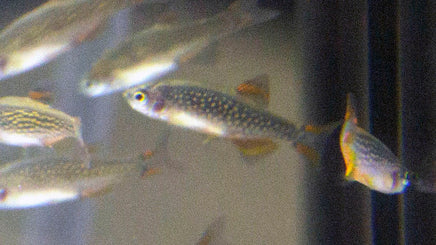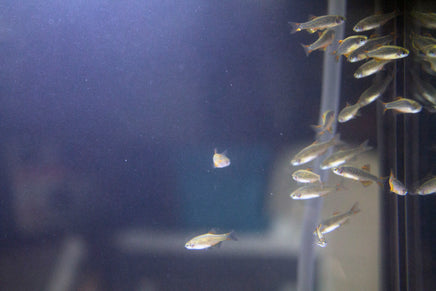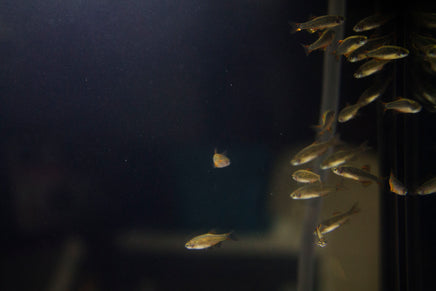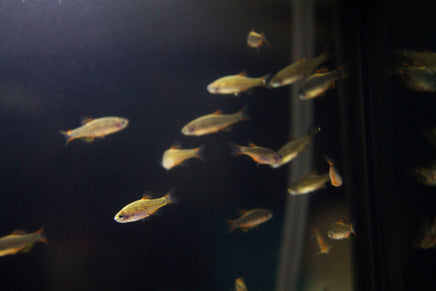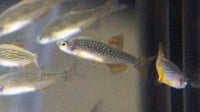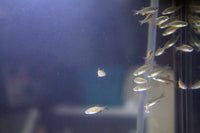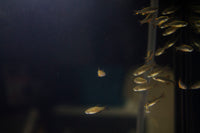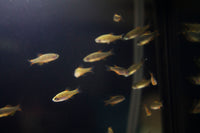Galaxy Rasbora (Danio margaritatus) - AKA Celestial Pearl Danio
Discovered in 2006, the species quickly appeared in the aquarium trade, where its small size and bright colors made it an instant hit.
This species shows some sexual dimorphism: males have a bright-blue background color (dull blue-green in females), and their fins are more brightly colored. The tail end of their bodies (the caudal peduncle) is also higher than in females. The body is sprinkled with small, pearly dots. The back is bronzy green, and the belly in females is yellowish-white. The gill covers are transparent, letting the blood-red gills shine through.
The males will prominently display their unpaired fins to conspecifics. All fins, save the pectoral fins, show two parallel black lines with a bright red area in between; on the tail fin, this pattern is present twice (once on each lobe) and the outer black band is vestigial. Females have a weaker version of the pattern in the tail and dorsal fins only, sometimes in the anal fin, too.
A courting male develops a red belly and the flanks brighten and darken, making the pearly spots stand out even more, with the back appearing paler than the flanks and also standing out. A female in reproductive age can be recognized by a black anal spot which separates the belly color from the uniformly reddish base of the anal fin. The male has a small black pad at the edges of the lower jaw, which is absent or reduced in females. Immature fish show some indication of a striped pattern, which eventually decomposes into the pearly dots.
The celestial pearl danio is a rather undemanding fish if its basic requirements are being met. It seems quite hardy, but obviously thrives best in fairly soft and slightly alkaline water at not too high a temperature—conditions that can often be met with treated tap water. It does not require much space, as it is not a very active swimmer, and is not a true shoaling fish, meaning it does not require large numbers of conspecifics for its well-being. In a small tank, a group of six individuals—half males, half females—will do well and exhibit natural behavior. They tend to be rather stationary, hovering in a peculiar position in favorite spots; males and females tend to keep separate when at rest. Altogether, their behavior again resembles Danio erythromicron more than other fish.
Tanks for the celestial pearl danio should be well-planted and direct daylight may be favorable (the natural habitat is so shallow as to be well lit throughout). Water weed and similar plants should be abundant, and stones and wood to create hiding spots should be provided. It is advisable to supply the fish with a spawning mop or a dense growth of suitable plants (java moss has been successfully used). A dense tangle of natural plants for spawning has the additional advantage of harboring protists on which the fry feed initially. The celestial pearl danio seems overall quite peaceful, though some fin-nipping occurs. Consequently, it cannot be kept with large or "bully" fish. Small, swarming danionins which require similar water conditions would be a natural choice for company, as such more active species provide nice contrast behaviorally and, being available in a wide range of colors and patterns, also make it possible to choose fish that complement the brilliant colors of D. margaritatus. Many danionins prefer slightly acidic water, however, and maintaining the rather high pH found across the Inle basin seems a necessary condition to keep fish from there successfully.

